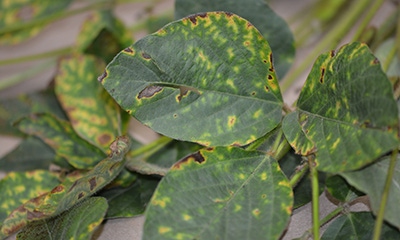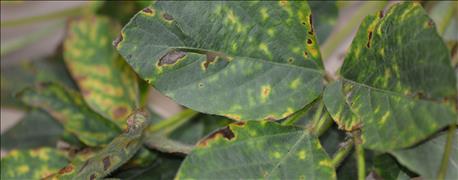
Scientists with the Minnesota Invasive Terrestrial Plants and Pests Center have compiled a 92-page white paper that ranks the top 124 invaders in the state.
Now they’re looking for input from the public.
The paper, "Minnesota's Top 124 Terrestrial Invasive Plants and Pests: Priorities for Research" is a result of a 14-scientist panel’s work to identify significant invasive plants, pathogens or insects. The paper ranks the invaders and the potential threats they pose by category, using 17 different criteria such as current location, potential damage to ecosystems and whether the invader can survive in Minnesota’s climate.

Made the list. According to a U-M white paper, Soybean Sudden Death ranked 13th on a list of the top 39 invasive plant pathogens that threaten Minnesota’s landscape.
Input from citizens is needed to finalize the rankings. The results will be used to set funding priorities for MITPPC projects.
Farmers will recognize numerous ‘winners’ that made the top 124 list: soybean aphid, several moths and beetles, different types of wilts, and probably more than half of the 45 invasive plants/weeds.
Funding needs for research on terrestrial invasive species far exceed the resources that are currently available, said Rob Venette, center director, so the rankings are intended to ensure a consistent, transparent process to determine priorities for future research.
The white paper is available to read at: www.mitppc.umn.edu
Comments will be accepted via the website through July 29
The researchers would like responses to three questions:
1.Do you have any additional information or experience that might affect the ratings that were assigned to each species?
2.Of the 124 taxa listed, which five do you think pose the greatest threat to Minnesota?
3.Would you recommend any additional terrestrial invasive species that are not on the list to be added next year as we update the list?
MITPPC is located within the College of Food, Agricultural and Natural Resource Sciences. It was established by the Minnesota Legislature in 2014. The legislatively mandated purpose of the MITPPC is "to prevent and minimize the threats posed by terrestrial invasive plants, other weeds, pathogens, and pests in order to protect the state's prairies, forests, wetlands, and agricultural resources." Funds are provided through the Minnesota Environment and Natural Resources Trust Fund.
About the Author(s)
You May Also Like






